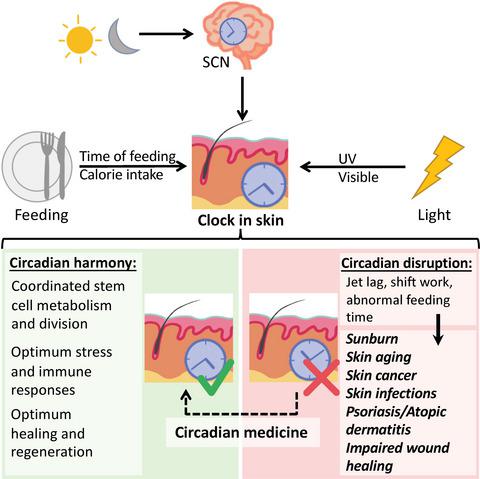当前位置:
X-MOL 学术
›
FEBS Lett.
›
论文详情
Our official English website, www.x-mol.net, welcomes your feedback! (Note: you will need to create a separate account there.)
The circadian clock and diseases of the skin
FEBS Letters ( IF 3.5 ) Pub Date : 2021-09-17 , DOI: 10.1002/1873-3468.14192 Junyan Duan 1 , Elyse Noelani Greenberg 2, 3 , Satya Swaroop Karri 2 , Bogi Andersen 1, 2, 3, 4
FEBS Letters ( IF 3.5 ) Pub Date : 2021-09-17 , DOI: 10.1002/1873-3468.14192 Junyan Duan 1 , Elyse Noelani Greenberg 2, 3 , Satya Swaroop Karri 2 , Bogi Andersen 1, 2, 3, 4
Affiliation

|
Organisms have an evolutionarily conserved internal rhythm that helps them anticipate and adapt to daily changes in the environment. Synchronized to the light–dark cycle with a period of around 24 hours, the timing of the circadian clock is set by light-triggering signals sent from the retina to the suprachiasmatic nucleus. Other inputs, including food intake, exercise, and temperature, also affect clocks in peripheral tissues, including skin. Here, we review the intricate interplay between the core clock network and fundamental physiological processes in skin such as homeostasis, regeneration, and immune- and stress responses. We illustrate the effect of feeding time on the skin circadian clock and skin functions, a previously overlooked area of research. We then discuss works that relate the circadian clock and its disruption to skin diseases, including skin cancer, sunburn, hair loss, aging, infections, inflammatory skin diseases, and wound healing. Finally, we highlight the promise of circadian medicine for skin disease prevention and management.
中文翻译:

生物钟和皮肤疾病
生物体具有进化上保守的内部节律,可以帮助它们预测和适应环境的日常变化。生物钟与大约 24 小时周期的明暗周期同步,由从视网膜发送到视交叉上核的光触发信号来设定。其他输入,包括食物摄入、运动和温度,也会影响包括皮肤在内的外周组织的时钟。在这里,我们回顾了核心时钟网络与皮肤基本生理过程(例如稳态、再生以及免疫和应激反应)之间复杂的相互作用。我们说明了喂养时间对皮肤生物钟和皮肤功能的影响,这是一个以前被忽视的研究领域。然后,我们讨论与生物钟及其破坏与皮肤病相关的研究,包括皮肤癌、晒伤、脱发、衰老、感染、炎症性皮肤病和伤口愈合。最后,我们强调昼夜节律医学在皮肤病预防和管理方面的前景。
更新日期:2021-10-12
中文翻译:

生物钟和皮肤疾病
生物体具有进化上保守的内部节律,可以帮助它们预测和适应环境的日常变化。生物钟与大约 24 小时周期的明暗周期同步,由从视网膜发送到视交叉上核的光触发信号来设定。其他输入,包括食物摄入、运动和温度,也会影响包括皮肤在内的外周组织的时钟。在这里,我们回顾了核心时钟网络与皮肤基本生理过程(例如稳态、再生以及免疫和应激反应)之间复杂的相互作用。我们说明了喂养时间对皮肤生物钟和皮肤功能的影响,这是一个以前被忽视的研究领域。然后,我们讨论与生物钟及其破坏与皮肤病相关的研究,包括皮肤癌、晒伤、脱发、衰老、感染、炎症性皮肤病和伤口愈合。最后,我们强调昼夜节律医学在皮肤病预防和管理方面的前景。


























 京公网安备 11010802027423号
京公网安备 11010802027423号